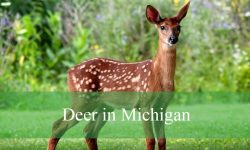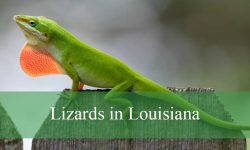Tennessee is home to many fascinating bird species, and gray birds are among the most easily spotted across the state. Their soft, neutral colors make them blend into a variety of landscapes, from city streets to forest trails and grassy fields.
This article highlights 18 gray birds in Tennessee, with pictures and helpful identification tips. Each bird is described by its size, markings, behavior, and preferred habitat, making it easier for birdwatchers and nature enthusiasts to recognize them in the wild.
Gray birds in Tennessee may not have bright feathers, but they stand out through their songs, flight patterns, and unique habits. Knowing how to identify these birds adds depth and enjoyment to any outdoor experience.
Common Gray Birds Found in Tennessee
Northern Mockingbird (Mimus polyglottos)
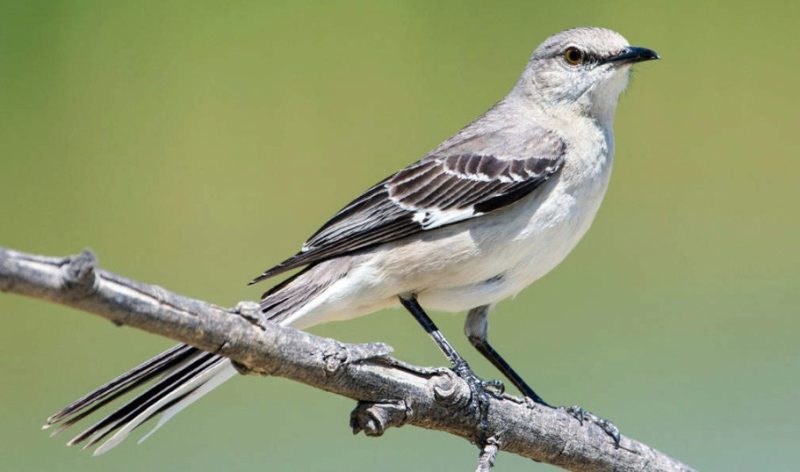
The Northern Mockingbird is a medium-sized, sleek gray bird with a long tail and distinct white patches on its wings, which are especially visible in flight. Its smooth plumage and elegant posture make it easy to recognize, particularly when perched on fences or treetops. The bird has a pale breast and a slightly curved, dark bill that enhances its alert, expressive look.
One of the most famous traits of this species is its incredible ability to mimic the songs of other birds, animals, and even mechanical noises. A single mockingbird may sing dozens of different tunes in rapid succession, often switching patterns every few seconds. Males sing most actively during the spring and early summer to defend territory and attract mates, and they may even continue singing through the night under moonlight.
In Tennessee, the Northern Mockingbird is one of the most widespread gray birds, frequently seen in suburban neighborhoods, open parks, farmlands, and roadside shrubs. It thrives in edge habitats where trees and open spaces meet, and it is commonly spotted across both urban and rural areas throughout the state.
Tufted Titmouse (Baeolophus bicolor)
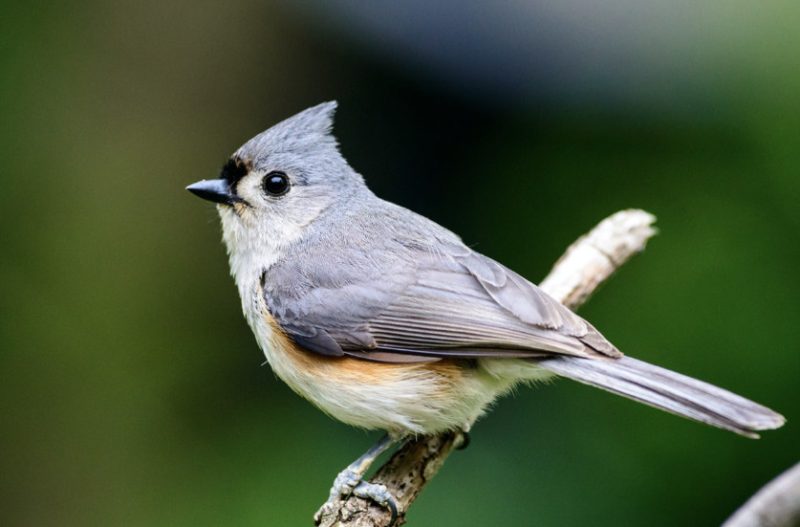
The Tufted Titmouse is a small, plump songbird with soft gray upperparts, a white belly, and a characteristic pointed crest on its head. It also features a black patch just above the beak, giving it a curious and alert expression. Its large black eyes and short, stout bill make it both cute and easily recognizable.
This bird has a clear, whistled song that sounds like “peter-peter-peter,” often repeated in quick succession. It also makes high-pitched chirps and calls while foraging in groups. The Tufted Titmouse is very active and inquisitive, commonly seen hopping along branches or hanging upside down to look for insects, seeds, and berries.
In Tennessee, Tufted Titmice are permanent residents of deciduous and mixed woodlands, but they are also frequent visitors to backyard bird feeders, especially those offering sunflower seeds and suet. They are abundant across the state, especially in forested suburbs, parks, and wooded countryside.
Blue-gray Gnatcatcher (Polioptila caerulea)
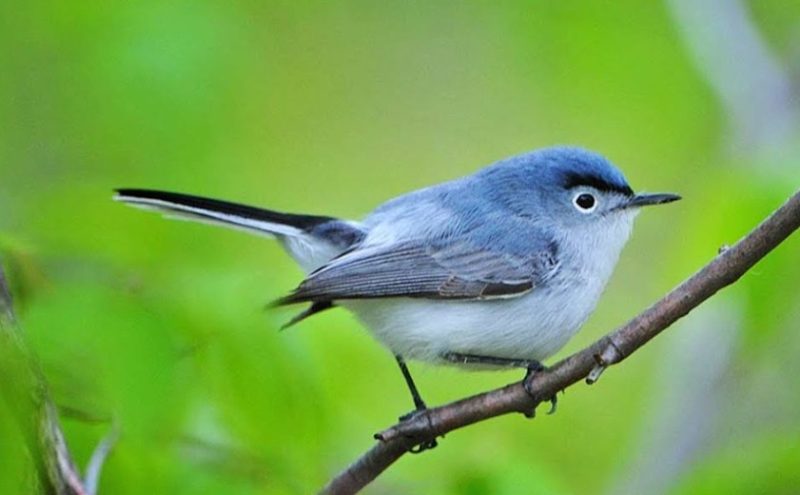
The Blue-gray Gnatcatcher is a tiny, delicate songbird with a soft blue-gray back, white underparts, and a long, narrow tail with white edges. It has a thin black beak and subtle white eye-rings, giving it a sharp but gentle appearance. The bird’s slender build and constant movement make it one of the more energetic gray birds.
Its vocalizations are high-pitched, thin, and slightly nasal, often resembling a series of soft “tsee-tsee” notes. It’s frequently heard before it’s seen due to its quick and elusive behavior. Blue-gray Gnatcatchers forage restlessly, flicking their tails to flush out insects and spiders from foliage, often darting and hovering in pursuit of prey.
In Tennessee, this species is most commonly seen in the warmer months, from spring through early fall. It prefers woodland edges, mature forests, and shrubby habitats near water. Migratory in nature, it nests throughout the state during the breeding season but moves south for the winter.
Gray Catbird (Dumetella carolinensis)
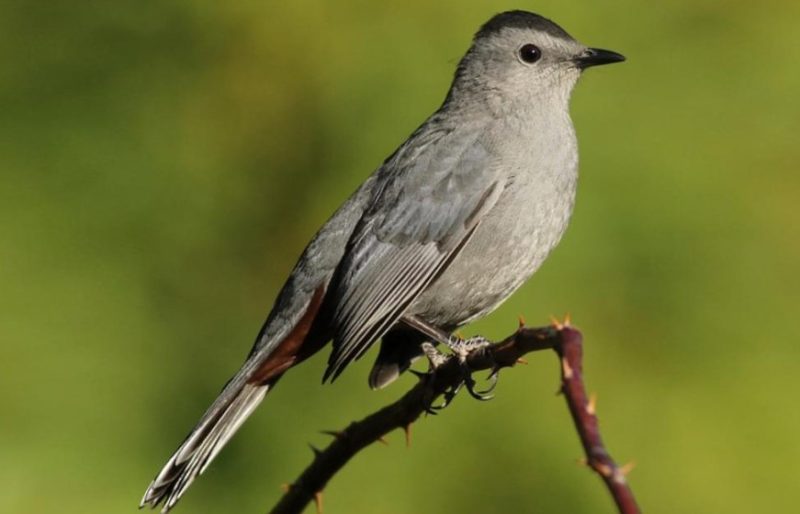
The Gray Catbird is a medium-sized, slate-gray songbird with a rounded body, black cap, and a distinct rusty-colored patch beneath its tail. Its name comes from its signature call—a harsh, nasal “mew” that resembles the sound of a cat. It also has a rich, varied song that mimics other birds but is more disjointed and scratchy than the mockingbird’s.
Unlike some other songbirds, the Gray Catbird prefers to remain hidden in dense thickets, shrubs, and forest edges. It often sings from inside the vegetation, flicking its tail or hopping between branches with a secretive demeanor. When agitated, it may give a sharp “tack” call as a warning.
In Tennessee, Gray Catbirds are summer residents and breeders, typically arriving in late spring and departing in early fall. They favor suburban gardens with thick hedges, river edges, and woodland clearings with undergrowth. They are more often heard than seen, especially when nesting.
Loggerhead Shrike (Lanius ludovicianus)

The Loggerhead Shrike is a distinctive gray bird with bold black markings across its face and wings, giving it a masked, raptor-like look. It has a heavy, hooked beak—unusual for a songbird—and pale gray upperparts with lighter underparts. Despite its small size, it has the silhouette of a small predator.
Known for its unique hunting behavior, this shrike impales prey such as insects, lizards, and small rodents on thorns or barbed wire to eat later. Its call is a mix of harsh rasping notes and soft whistles. While it can mimic other bird calls, it’s more reserved in its vocalizations compared to mockingbirds or catbirds.
In Tennessee, Loggerhead Shrikes are found in open habitats like farmlands, pastures, and roadside fields. They prefer areas with scattered trees or fence lines, which offer perching and hunting vantage points. Although once common, their numbers have declined in some areas due to habitat loss, making sightings less frequent than in past decades.
Eastern Kingbird (Tyrannus tyrannus)

The Eastern Kingbird is a medium-sized songbird with a striking appearance—mostly gray on the back with crisp white underparts and a black head. Its tail is square and tipped with a distinct white band, making it easy to identify in flight. The bird also has a hidden crown patch of red or orange, which it rarely displays during confrontations.
Highly territorial and aggressive, Eastern Kingbirds are fearless defenders of their nests and often chase off much larger birds such as hawks and crows. Their call is a sharp, buzzing “zeer” or “kit-kit,” often heard during flight. They frequently perch on wires or exposed branches, sallying out to catch flying insects midair.
In Tennessee, these birds are common in spring and summer, especially near open fields, pastures, and forest edges. They prefer habitats with scattered trees and nearby water sources, making them a regular sight along riverbanks and rural landscapes.
Mourning Dove (Zenaida macroura)
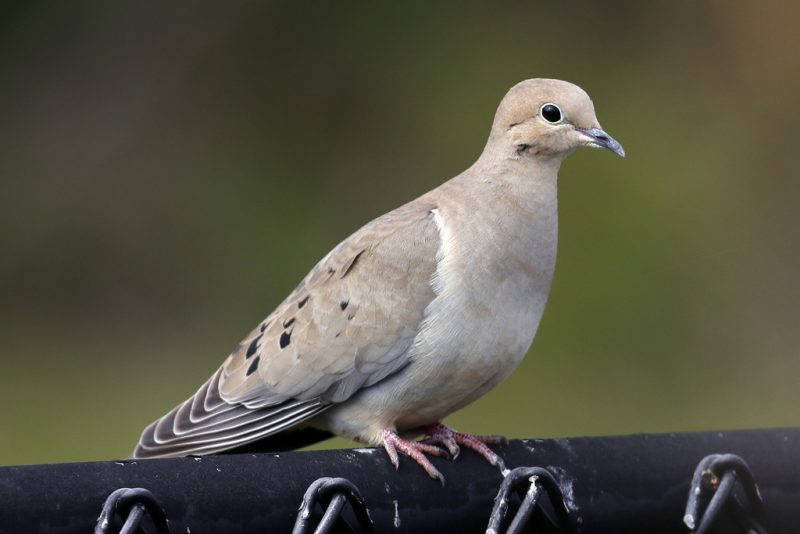
The Mourning Dove is a slender, pale grayish-tan bird with a small head, long pointed tail, and black spots on its wings. Its soft coloring and streamlined body give it a graceful, gentle appearance. When perched, the tail’s white edges and tapered shape are distinguishing features.
Its call—a slow, mournful “coo-oo-oo”—is one of the most familiar and evocative bird sounds in North America. Mourning Doves are often seen foraging on the ground, where they peck at seeds and grains. When flushed, they take off with a distinctive whistling of the wings, which acts as an alarm signal.
In Tennessee, Mourning Doves are abundant year-round in both urban and rural environments. They are commonly found in gardens, farms, roadsides, and telephone wires, where they rest between feeding flights. Their adaptability allows them to thrive from city centers to quiet countryside fields.
Dark-eyed Junco (Junco hyemalis)

The Dark-eyed Junco is a small, round-bodied sparrow with slate-gray plumage, a clean white belly, and a pale pink bill. This species shows slight regional variation, but in Tennessee, the “slate-colored” form is the most common during the colder months. The contrast between the dark upperparts and bright underparts gives it a striking winter look.
Juncos have a soft, musical trill and high-pitched contact calls that are often heard as they forage in flocks. These birds are ground feeders, hopping briskly under shrubs or along forest edges in search of seeds. They frequently flick their tails to reveal white outer feathers, which flash during short flights.
In Tennessee, Dark-eyed Juncos are winter visitors, arriving in late fall and departing by early spring. They are found in wooded areas, brushy fields, and suburban yards, particularly around feeders. Their numbers increase notably during snowfalls when they move into more visible open areas.
European Starling (Sturnus vulgaris)
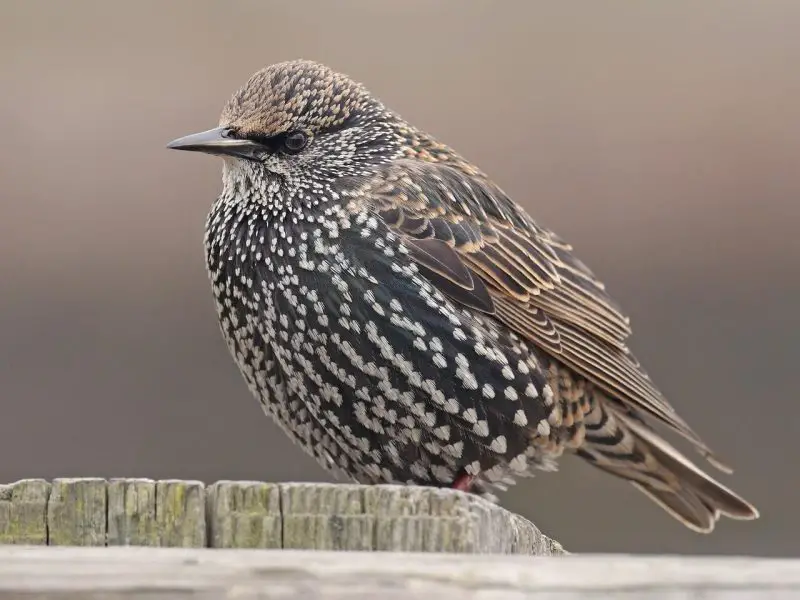
European Starlings are stocky, medium-sized birds that often appear dark gray or black from a distance, but their plumage reveals an iridescent sheen of green and purple in sunlight. In winter, they develop pale speckles across their feathers, while their yellow bill darkens. Their short tail and triangular wings give them a swift, pointed silhouette in flight.
They are extremely vocal, producing a wide range of whistles, clicks, and mimicked sounds. Starlings are known for their tight, swirling flocks—called murmurations—which form dramatic aerial displays. On the ground, they walk with confidence, probing for insects or seeds in lawns and fields.
In Tennessee, starlings are found statewide in all seasons. They thrive in cities, farmlands, and open fields, nesting in cavities and often competing aggressively with native species for space. Their adaptability and social behavior make them one of the most widespread birds in the region.
Northern Rough-winged Swallow (Stelgidopteryx serripennis)
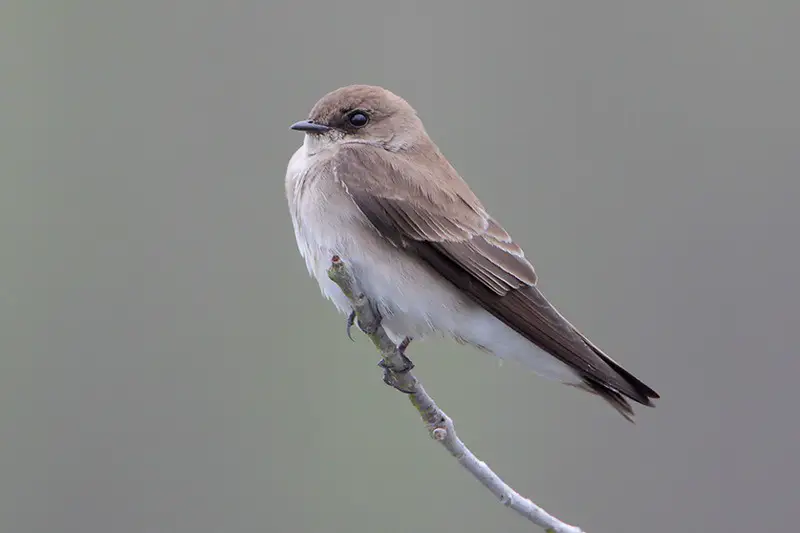
The Northern Rough-winged Swallow is a small, slender bird with plain brownish-gray upperparts and a lighter throat and belly. Its coloring is subdued compared to other swallows, lacking the glossy sheen or bright contrasts. Its name comes from the tiny hooked barbs on the outer wing feathers of adult males, although this feature isn’t visible from a distance.
Its vocalizations are soft, dry trills and chips, often given in flight. This species flies low and steadily over water, fields, or roads while catching insects on the wing. It’s less social than other swallows, usually seen alone or in small groups, especially outside of nesting season.
In Tennessee, Northern Rough-winged Swallows arrive in spring and are commonly seen through summer near lakes, rivers, streams, and even roadside ditches. They nest in burrows or crevices, including man-made structures like drainpipes and bridge undersides, making them well adapted to both natural and urban waterways.
Canada Goose (Branta canadensis)
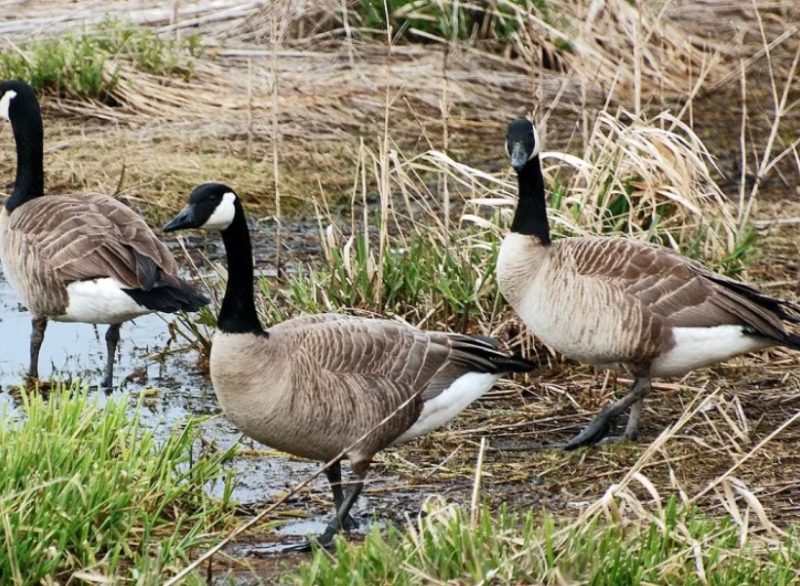
The Canada Goose is a large, easily recognizable waterfowl with a gray-brown body, black neck and head, and a distinctive white cheek patch. Its long, black neck and honking call make it unmistakable, especially when flying in V-shaped flocks overhead. These geese are strong, graceful flyers and swimmers, often seen gliding across ponds and lakes.
Their call is a loud, resonant “honk” that can be heard over long distances, especially during migration. Canada Geese are social birds and form strong family groups, often seen feeding together on grasses or grains. They are also quite territorial during breeding season and may hiss or charge intruders near their nests.
In Tennessee, Canada Geese are widespread year-round but are especially noticeable in fall and winter when migratory flocks arrive. They are common around lakes, rivers, reservoirs, parks, golf courses, and agricultural fields, where open water and short grass provide ideal habitat.
Rock Pigeon (Columba livia)

The Rock Pigeon, commonly known as the city pigeon, is a medium-sized bird with a plump body and variable plumage. Many individuals have pale gray bodies with two bold black wing bars, iridescent green and purple neck feathers, and dark tails. Others may appear in shades of blue-gray, brown, or even white due to domesticated lineage.
These birds are highly adaptable and often seen walking on sidewalks, perching on buildings, or roosting under bridges. Their calls include a soft cooing sound, which is often heard in flocks. Rock Pigeons feed on scattered grain, food scraps, and seeds, and are rarely shy around humans.
In Tennessee, Rock Pigeons are a common sight in cities and towns, especially in downtown areas, train stations, and near food sources. Although originally native to Europe and Asia, they now thrive across the state in both urban and rural settings, where nesting sites and food are plentiful.
Belted Kingfisher (Megaceryle alcyon)
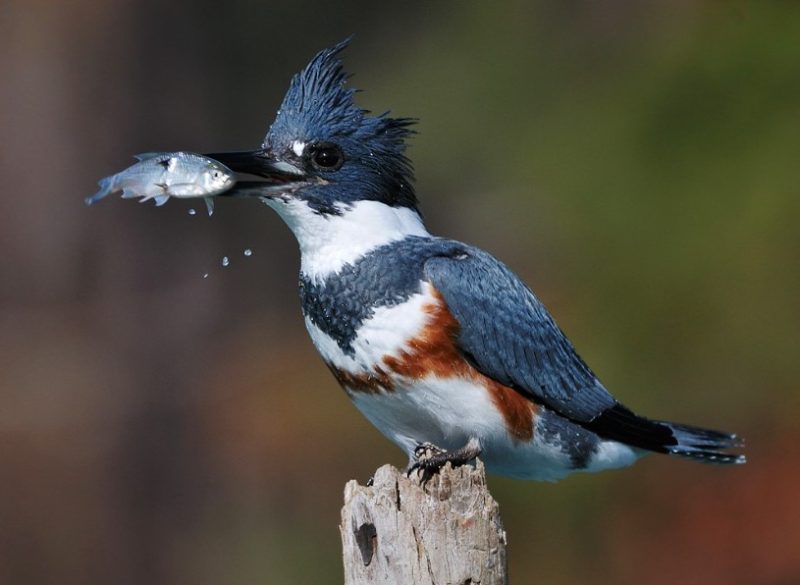
The Belted Kingfisher is a stocky bird with a large head, shaggy crest, and thick, pointed bill. It has blue-gray upperparts and a white belly crossed by a bold blue breast band. Females have an additional rusty band across the belly, making them one of the few bird species where females are more colorful than males.
Its rattling, mechanical call is often heard before the bird is seen, echoing across rivers and lakes. The kingfisher is usually spotted perched quietly on a branch overhanging water, scanning for fish. Once prey is spotted, it dives headfirst into the water to catch it with impressive accuracy.
In Tennessee, Belted Kingfishers are found near streams, ponds, lakes, and rivers throughout the year. They nest in burrows dug into sandy banks and are most active during the breeding season in spring and summer, although some remain in the state even during winter if water remains unfrozen.
Killdeer (Charadrius vociferus)

The Killdeer is a medium-sized shorebird with brownish-gray upperparts, white underparts, and two bold black bands across its chest. It has long legs and a slender body, which help it move quickly across open ground. Its bright orange rump is visible in flight, adding a flash of color to its otherwise subtle plumage.
Killdeer are known for their loud, high-pitched “kill-deer” call, which they give while flying or running. They are very active birds, often seen darting around open fields, gravel roads, or parking lots. When threatened near their nests, they perform a dramatic “broken-wing” act to lure predators away.
In Tennessee, Killdeer are commonly found in open habitats such as farm fields, grassy lawns, riverbanks, and construction sites. They are year-round residents in many parts of the state, especially in lowland areas, and are among the most frequently observed shorebirds far from actual water bodies.
When and Where to See Gray Birds in Tennessee
The best times to see gray birds in Tennessee are during the spring and summer months when many species are actively breeding and more visible. Early mornings and late afternoons offer the most bird activity, as birds forage and sing during these cooler parts of the day.
Gray birds can be found across a variety of habitats throughout the state—from suburban yards and city parks to forests, wetlands, and open fields. For example, Northern Mockingbirds and Mourning Doves are common in neighborhoods, while species like the Blue-gray Gnatcatcher prefer wooded areas.
To increase your chances of spotting these birds, visit nature preserves, riverbanks, and wildlife refuges where natural habitats remain undisturbed. Seasonal migrations also bring some gray birds to Tennessee in the fall and winter, providing additional opportunities for observation.

